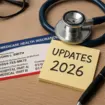Prescription Drug Plans

What Are Prescription Drug Plans (Part D)?
Prescription Drug Plans, also known as Medicare Part D, help Medicare beneficiaries manage the cost of their medications. These plans can be added to Original Medicare (Parts A and B) or included as part of Medicare Advantage (Part C) plans that offer drug coverage.
Medicare Part D was created to help Medicare beneficiaries afford prescription drugs and reduce the out-of-pocket expenses for medications. As of 2024, approximately 53.1 million people are enrolled in Medicare Part D, the prescription drug program within Medicare, with about 60% of these beneficiaries opting for coverage through Medicare Advantage Prescription Drug Plans (MAPDs) instead of stand-alone Part D plans1. This shift reflects a growing trend towards MAPD plans, which often integrate Part D drug coverage with other Medicare Advantage benefits, offering a comprehensive package that appeals to many beneficiaries.
What Types of Coverage Do Prescription Drug Plans Offer?
Prescription Drug Plans cover a range of prescription medications, including both brand-name and generic drugs. Each plan has its own formulary, which lists the medications covered and organizes them by “tiers” to help control costs. Coverage is offered through private insurance companies approved by Medicare.
How much do Prescription Drug Plans Cost?
Prescription Drug Plans typically have monthly premiums, copayments or coinsurance, and an annual deductible. Costs vary by plan, with some low-cost options available. Additionally, high-income earners may pay an extra monthly premium based on income.

LOOKING FOR HELP WITH DRUG COSTS?
Learn about Medicare's Extra Help ProgramWho Is Eligible for Prescription Drug Plans (Part D)?
Prescription Drug Plans are available to individuals who meet specific eligibility criteria, primarily focusing on those who qualify for Medicare.
Some of the major eligibility criteria include:
1. Individuals Eligible for Medicare Parts A and/or B
Anyone eligible for Medicare Part A (hospital insurance) or enrolled in Medicare Part B (medical insurance) can enroll in a Prescription Drug Plan. Most commonly, this includes people who are 65 or older. Prescription Drug Plan coverage is not automatic; eligible individuals must actively choose a Prescription Drug Plan or a Medicare Advantage plan that includes drug coverage.
2. Individuals Under 65 with Certain Disabilities
Individuals under 65 who receive Social Security Disability Insurance (SSDI) for 24 months are also eligible for Medicare and, by extension, can enroll in Prescription Drug Plans. After 24 months of receiving SSDI, these beneficiaries are automatically enrolled in Parts A and B and can choose a Prescription Drug Plan if they want drug coverage.
Individuals with End-Stage Renal Disease (ESRD)
Those diagnosed with End-Stage Renal Disease (ESRD) are eligible for Medicare regardless of age and can enroll in Prescription Drug Plans. ESRD beneficiaries have unique Medicare eligibility due to the need for dialysis or a kidney transplant.
4. Special Circumstances for Late Enrollment
Certain individuals who delay enrollment in Prescription Drug Plans (Medicare Part D) due to other credible prescription drug coverage can enroll later without facing late enrollment penalties, provided they enroll within 63 days of losing other drug coverage.

WANT TO KNOW HOW MEDICARE IS CHANGING NEXT YEAR?
Explore Medicare 2026 ChangesWhen Can You Enroll in Prescription Drug Plans?
Medicare offers multiple enrollment periods throughout the year, each with specific guidelines on when and how beneficiaries can enroll, change, or drop prescription drug coverage.
| Enrollment Period | Timing | Purpose |
|---|---|---|
| Initial Enrollment Period (IEP) | 3 months before, the month of, and 3 months after turning 65 | Enroll for first-time as new Medicare beneficiaries. |
| Annual Enrollment Period (AEP) | October 15 - December 7 | Join, switch, or drop Prescription Drug Plans or Medicare Advantage plans (with or without drug coverage). Changes take effect on January 1 of the following year. |
| Medicare Advantage Open Enrollment Period (MA OEP) | January 1 - March 31 | Make a one-time change (if already enrolled in Medicare Advantage) to another Medicare Advantage plan or return to Original Medicare (Parts A and B) and add a Prescription Drug Plan. |
| Special Enrollment Period (SEP) | Varies based on qualifying event | Enroll or make changes outside of AEP if experiencing certain life events (e.g., losing creditable coverage, moving out of a plan’s area, Medicaid changes, entering or leaving a care facility). |
| General Enrollment Period (GEP) | January 1 - March 31 | If you missed IEP, enroll in Part A and/or Part B. After enrolling in Part B, join Medicare Part D, with coverage beginning July 1 (late enrollment penalty may be incurred if you didn't enroll when first eligible.). |
| Five-Star Special Enrollment Period | December 8 - November 30 | You can make a one-time change to a five-star Prescription Drug Plan or Medicare Advantage plan if available in your area, regardless of other enrollment periods. |

LOOKING FOR MEDICARE KEY DATES?
View Enrollment DeadlinesWhat Are the Types of Prescription Drug Plans Available?
Medicare offers two primary types of plans designed to help beneficiaries cover prescription drug costs. These types provide flexibility depending on whether an individual has Original Medicare (Parts A and B) or Medicare Advantage.
1. Stand-Alone Prescription Drug Plans (PDPs)
Description:
These plans offer prescription drug coverage but do not include other medical services for people enrolled in Original Medicare (Parts A and B). PDPs work alongside Original Medicare, allowing beneficiaries to have comprehensive drug coverage without switching to a Medicare Advantage plan.Coverage:
Each PDP has a formulary (list of covered drugs) organized by tiers. Lower-tier drugs (often generics) have lower copays, while higher-tier drugs (brand-name or specialty medications) may have higher out-of-pocket costs.Availability:
PDPs are offered by private insurance companies approved by Medicare, and beneficiaries can choose from various plans in their region.
2. Medicare Advantage Plans with Prescription Drug Coverage (MAPDs)
Description:
These plans bundle Medicare Parts A, B, and D into a single plan, offering an "all-in-one" option for healthcare and prescription drugs. MAPDs combine drug coverage with the additional benefits of Medicare Advantage, such as dental, vision, and hearing services. Many MAPDs feature network restrictions (e.g., HMOs or PPOs), where members may need to use specific healthcare providers.Coverage:
Each PDP has a formulary (list of covered drugs) organized by tiers. Lower-tier drugs (often generics) have lower copays, while higher-tier drugs (brand-name or specialty medications) may have higher out-of-pocket costs.Availability:
Offered through private insurers, these plans vary widely by state and region, providing flexibility to meet the needs of beneficiaries interested in comprehensive coverage.

Looking to learn about Medicare Advantage?
Explore Medicare Advantage PlansHow Do You Choose the Right Prescription Drug Plan?
Choosing a Prescription Drug Plan requires comparing multiple factors to find a plan that best suits your healthcare needs, financial situation, and personal preferences.
Some of the main factors to consider:
1. Prescription Medications
Make a list of your current medications to ensure they’re covered by the plan. Check if the drugs are included in the plan’s formulary and if any restrictions (like prior authorization) apply.
2. Plan Formularies
A formulary is a list of drugs a plan covers, which can differ between plans. Make sure your medications are covered and are placed in lower-cost tiers, if possible.
3. Premiums, Deductibles, and Out-of-Pocket Expenses
Plans have different premiums, deductibles, and out-of-pocket costs, including copays and coinsurance. Consider both monthly costs and how much you’ll pay for your medications, including during the coverage gap.
4. Pharmacy Networks
Check which pharmacies are included in the plan’s network, as using non-network pharmacies may increase your costs. Some plans offer lower costs at preferred pharmacies or with mail-order options.
5. Plan Ratings and Customer Satisfaction
Medicare rates plans on a 5-star scale based on customer satisfaction and performance. Higher-rated plans generally offer better service and fewer complaints from members.
6. Future Needs and Flexibility
Consider whether the plan will meet your future medication needs. Choose a plan with a broad formulary or flexibility to accommodate new prescriptions as your healthcare needs change.
Consider your prescription needs, preferred pharmacy, budget, and whether you want to bundle with a Medicare Advantage plan that includes drug coverage. Comparing multiple plans and consulting with a licensed insurance advisor can help you find the best fit.
We are here to help.
Speak with a licensed insurance agent
OR
Other options
1 KFF, Key Facts About Medicare Part D Enrollment, Premiums, and Cost Sharing in 2024, Key Facts About Medicare Part D Enrollment, Premiums, and Cost Sharing in 2024, Jul 2, 2024


